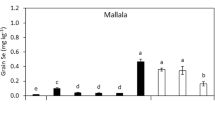Abstract
Selenium (Se) is an essential micronutrient for human health, but its deficiency may affect at least one billion people worldwide. Plants and plant-derived products transfer the soil-uptaken Se to humans through the food chain, which is hardly enough when soils have been always poor or already exhausted in bioavailable Se species. Other than agronomic approaches for enhancing Se levels in cereals, such as soil and foliar supplements, seed enrichment may be viewed as an alternative Se-biofortification technique. This study addresses the protocol for preparing Se-enriched wheat seeds, with the specific purpose of optimizing the administration of Se to the seeds prior to sowing. The first step was to soak an amount of bread-wheat seeds in an active Se solution, made with irradiated [Na2O4Se], and then monitoring 75Se in periodically-retrieved samples from that original amount. To avoid losing Se to soil (after sowing), and, especially, to ensure that Se gets really absorbed into the seeds—and not just adsorbed onto them—the washing time of the seeds should be optimized as well. This was carried out by washing Se-treated seeds several times, until no significant amount of the radiotracer could be detected in the washing water. In what concerns the full optimization procedure, the overall results of the present study point to an optimum time of 48 h for soaking and 24 h for washing.



Similar content being viewed by others
References
Marzec Z, Marzec A, Zaręba S (2002) Med Weter 58:705–707
McNaughton SA, Marks GC (2002) J Food Compos Anal 15:169–182
Klapec T, Mandić ML, Grgić J, Primorac L, Perl A, Krstanović V (2004) Food Chem 85:445–452
Sirichakwal PP, Puwastien P, Polngam J, Kongkachuichai R (2005) J Food Compos Anal 18:47–59
Pappa EC, Pappas AC, Surai PF (2006) Sci Total Environ 372:100–108
Navarro-Alarcon M, Cabrera-Vique C (2008) Sci Total Environ 400:115–141
Srikumar TS, Johansson GK, Ockerman PA, Gustafsson JA, Akesson B (1992) Am J Clin Nutr 55:885–890
Donovan UM, Gibson RS, Ferguson EL, Ounpuu S, Heywood P (1992) J Trace Elem Electrol Health Dis 6:39–43
Lyons G, Stangoulis J, Graham R (2003) Nutr Res Rev 16:45–60
Lyons GH, Judson GF, Ortiz-Monasterio I, Genc Y, Stangoulis JCR, Graham RD (2005) J Trace Elem Med Biol 19:75–82
Dumont E, Vanhaecke F, Cornelis R (2006) Anal Bioanal Chem 385:1304–1323
Lorenz K, Lee VA, Jackel SS (1977) Crit Rev Food Sci 8:383–456
Shewry PR, Halford NG (2002) J Exp Bot 53:947–958
Lyons GH, Lewis J, Lorimer MF, Holloway RE, Brace DM, Stangoulis JCR, Graham RD (2004) Food Agric Environ 2:171–178
Welch RM, Graham RD (2004) J Exp Bot 55:353–364
White PJ, Broadley MR (2005) Trends Plant Sci 10:586–593
Graham RD, Welch RM, Saunders DA, Ortiz-Monasterio I, Bouis HE, Bonierbale M, de Haan S, Burgos G, Thiele G, Liria R, Meisner CA, Beebe SE, Potts MJ, Kadian M, Hobbs PR, Gupta RK, Twomlow S (2007) Adv Agron 92:1–74
White PJ, Broadley MR (2009) New Phytol 182:49–84
Hawkesford MJ, Zhao F-J (2007) J Cereal Sci 46:282–292
Galinha C, Freitas MC, Pacheco AMG, Coutinho J, Maçãs B, Almeida AS (2011) J Radioanal Nucl Chem. doi:10.1007/s10967-011-1226-4
Smrkolj P, Osvald M, Osvald J, Stibilj V (2007) Eur Food Res Technol 225:233–237
Acknowledgments
This work has been supported by the Portuguese Foundation for the Science and the Technology (Fundação para a Ciência e a Tecnologia, FCT; Portugal) through research contract PTDC/QUI/65618/2006. One of the authors (A.S.A.) thanks FCT Ciência 2008 Program. The authors are also indebted to the anonymous Reviewers for their constructive remarks and helpful comments.
Author information
Authors and Affiliations
Corresponding author
Rights and permissions
About this article
Cite this article
Galinha, C., Freitas, M.C., Pacheco, A.M.G. et al. Radiotracing selenium in bread-wheat seeds for a Se-biofortification program: an optimization study in seed enrichment. J Radioanal Nucl Chem 291, 193–195 (2012). https://doi.org/10.1007/s10967-011-1262-0
Received:
Published:
Issue Date:
DOI: https://doi.org/10.1007/s10967-011-1262-0




